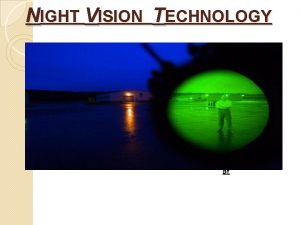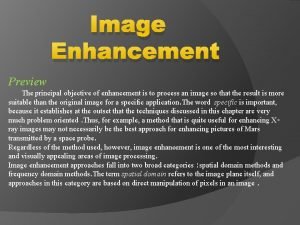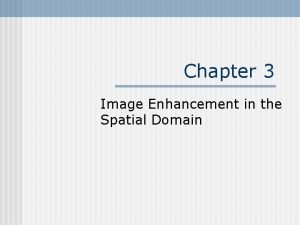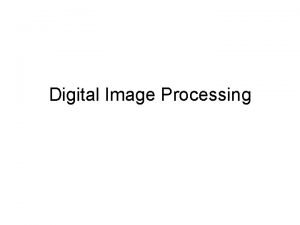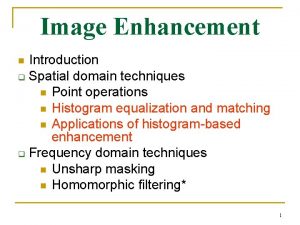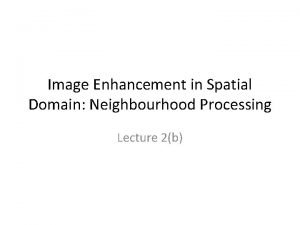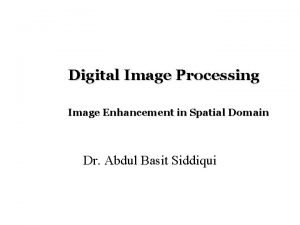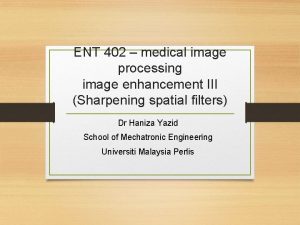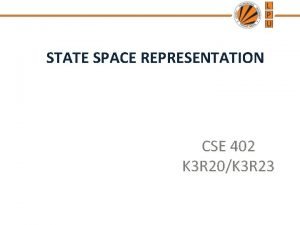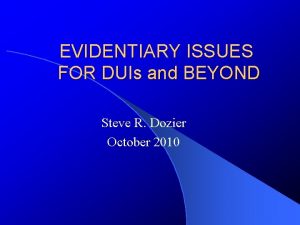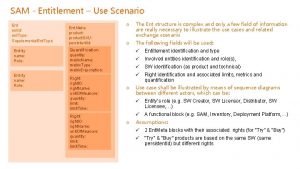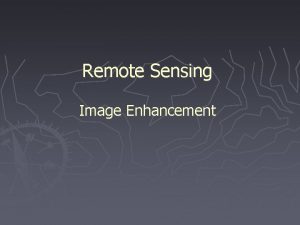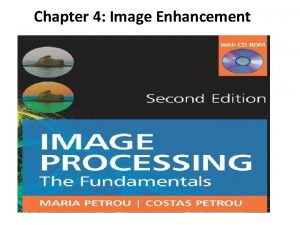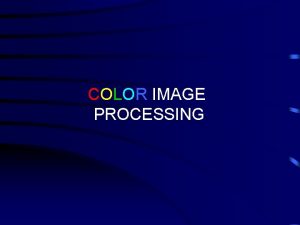ENT 402 medical image processing image enhancement III



































- Slides: 35

ENT 402 – medical image processing image enhancement III (Sharpening spatial filters) Dr Haniza Yazid School of Mechatronic Engineering Universiti Malaysia Perlis

Contents In this lecture we will look at more spatial filtering techniques • Spatial filtering refresher • Sharpening filters • 1 st derivative filters • 2 nd derivative filters • Combining filtering techniques

Origin Spatial Filtering Refresher x Simple 3*3 Neighbourhood y e 3*3 Filter Image f (x, y) a b c d e f g h i Original Image Pixels * r s t u v w x y z Filter eprocessed = v*e + r*a + s*b + t*c + u*d + w*f + x*g + y*h + z*i The above is repeated for every pixel in the original image to generate the smoothed image

Sharpening Spatial Filters Previously we have looked at smoothing filters which remove fine detail Sharpening spatial filters seek to highlight fine detail • Remove blurring from images • Highlight edges Sharpening filters are based on spatial differentiation

Images taken from Gonzalez & Woods, Digital Image Processing (2002) Spatial Differentiation measures the rate of change of a function Let’s consider a simple 1 dimensional example

Images taken from Gonzalez & Woods, Digital Image Processing (2002) Spatial Differentiation A B

1 st Derivative The formula for the 1 st derivative of a function is as follows: It’s just the difference between subsequent values and measures the rate of change of the function

2 nd Derivative The formula for the 2 nd derivative of a function is as follows: Simply takes into account the values both before and after the current value

5/19/2021 9

Using Second Derivatives For Image Enhancement The 2 nd derivative is more useful for image enhancement than the 1 st derivative • Stronger response to fine detail • Simpler implementation • We will come back to the 1 st order derivative later on The first sharpening filter we will look at is the Laplacian • Isotropic – whose response is independent of the direction of the discontinuities in the image. • One of the simplest sharpening filters • We will look at a digital implementation

The Laplacian is defined as follows: in the x direction is defined as follows: and in the y direction as follows:

The Laplacian (cont…) So, the Laplacian can be given as follows: We can easily build a filter based on this 0 1 -4 1 0

Images taken from Gonzalez & Woods, Digital Image Processing (2002) The Laplacian (cont…) Applying the Laplacian to an image we get a new image that highlights edges and other discontinuities Original Image Laplacian Filtered Image Scaled for Display

Images taken from Gonzalez & Woods, Digital Image Processing (2002) But That Is Not Very Enhanced! The result of a Laplacian filtering is not an enhanced image We have to do more work in order to get our final image Subtract the Laplacian result from the original image to generate our final sharpened enhanced image Laplacian Filtered Image Scaled for Display

Images taken from Gonzalez & Woods, Digital Image Processing (2002) Laplacian Image Enhancement Original Image = Laplacian Filtered Image Sharpened Image In the final sharpened image edges and fine detail are much more obvious

Images taken from Gonzalez & Woods, Digital Image Processing (2002) Laplacian Image Enhancement

Simplified Image Enhancement The entire enhancement can be combined into a single filtering operation

Images taken from Gonzalez & Woods, Digital Image Processing (2002) Simplified Image Enhancement (cont…) This gives us a new filter which does the whole job for us in one step 0 -1 5 -1 0

Images taken from Gonzalez & Woods, Digital Image Processing (2002) Simplified Image Enhancement (cont…)

Images taken from Gonzalez & Woods, Digital Image Processing (2002) Variants On The Simple Laplacian There are lots of slightly different versions of the Laplacian that can be used: 0 1 1 -4 1 0 Simple Laplacian 1 1 1 -8 1 1 -1 -1 9 -1 -1 Variant of Laplacian

Unsharp Masking and Highboost Filtering ► Unsharp masking Sharpen images consists of subtracting an unsharp (smoothed) version of an image from the original image e. g. , printing and publishing industry ► Steps 1. Blur the original image 2. Subtract the blurred image from the original 3. Add the mask to the original 5/19/2021 21

Unsharp Masking and Highboost Filtering When k = 1, the process is referred as unsharp masking 5/19/2021 22

Unsharp Masking: Demo 5/19/2021 23

Unsharp Masking and Highboost Filtering: Example 5/19/2021 24

1 st Derivative Filtering Implementing 1 st derivative filters is difficult in practice For a function f(x, y) the gradient of f at coordinates (x, y) is given as the column vector:

1 st Derivative Filtering (cont…) The magnitude of this vector is given by: For practical reasons this can be simplified as:

1 st Derivative Filtering (cont…) There is some debate as to how best to calculate these gradients but we will use: which is based on these coordinates z 1 z 2 z 3 z 4 z 5 z 6 z 7 z 8 z 9

Sobel Operators Based on the previous equations we can derive the Sobel Operators -1 -2 -1 -1 0 0 0 -2 0 2 1 -1 0 1 To filter an image it is filtered using both operators the results of which are added together

Images taken from Gonzalez & Woods, Digital Image Processing (2002) Sobel Example An image of a contact lens which is enhanced in order to make defects (at four and five o’clock in the image) more obvious Sobel filters are typically used for edge detection

1 st & 2 nd Derivatives Comparing the 1 st and 2 nd derivatives we can conclude the following: • 1 st order derivatives generally produce thicker edges • 2 nd order derivatives have a stronger response to fine detail e. g. thin lines • 1 st order derivatives have stronger response to grey level step • 2 nd order derivatives produce a double response at step changes in grey level

Images taken from Gonzalez & Woods, Digital Image Processing (2002) Combining Spatial Enhancement Methods Successful image enhancement is typically not achieved using a single operation Rather we combine a range of techniques in order to achieve a final result This example will focus on enhancing the bone scan to the right

Images taken from Gonzalez & Woods, Digital Image Processing (2002) Combining Spatial Enhancement Methods (cont…) (a) Laplacian filter of bone scan (a) (b) Sharpened version of bone scan achieved (c) by subtracting (a) Sobel filter of bone and (b) scan (a) (d)

Images taken from Gonzalez & Woods, Digital Image Processing (2002) Combining Spatial Enhancement Methods (cont…) Result of applying a The product of (c) and (e) which will be used as a mask (e) power-law trans. to Sharpened image (g) which is sum of (a) (g) and (f) Image (d) smoothed with a 5*5 averaging filter (f) (h)

Images taken from Gonzalez & Woods, Digital Image Processing (2002) Combining Spatial Enhancement Methods (cont…) Compare the original and final images

Summary In this lecture we looked at: • Sharpening filters • 1 st derivative filters • 2 nd derivative filters • Combining filtering techniques
 Define point processing
Define point processing Point processing operations
Point processing operations Histogram processing in digital image processing
Histogram processing in digital image processing A generalization of unsharp masking is
A generalization of unsharp masking is Point processing in image processing
Point processing in image processing Digital image processing
Digital image processing Image enhancement in night vision technology
Image enhancement in night vision technology Objective of image enhancement
Objective of image enhancement Contoh pelembutan citra
Contoh pelembutan citra Combining spatial enhancement methods
Combining spatial enhancement methods Digital enhancement definition
Digital enhancement definition Image enhancement in spatial domain
Image enhancement in spatial domain Image enhancement in spatial domain
Image enhancement in spatial domain Image enhancement in spatial domain
Image enhancement in spatial domain Gonzalez
Gonzalez Hamlet act iii scene ii
Hamlet act iii scene ii Idl medical ent
Idl medical ent Image transform in digital image processing
Image transform in digital image processing Optimum notch filter in image processing
Optimum notch filter in image processing Image compression in digital image processing
Image compression in digital image processing Image segmentation in digital image processing
Image segmentation in digital image processing Error free compression in digital image processing
Error free compression in digital image processing Image sharpening in digital image processing
Image sharpening in digital image processing Image geometry in digital image processing
Image geometry in digital image processing Isopreference curve
Isopreference curve Walsh transform in digital image processing
Walsh transform in digital image processing Imtransform matlab
Imtransform matlab Noise
Noise Cse 402
Cse 402 401 stitch type
401 stitch type Isae 3402 type b
Isae 3402 type b Ist 402
Ist 402 Ist 402
Ist 402 8884026916
8884026916 Tca 55-10-416
Tca 55-10-416 Ist 402
Ist 402






